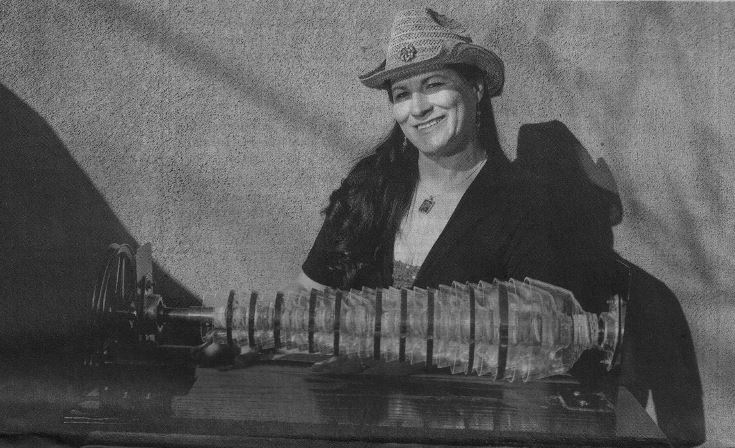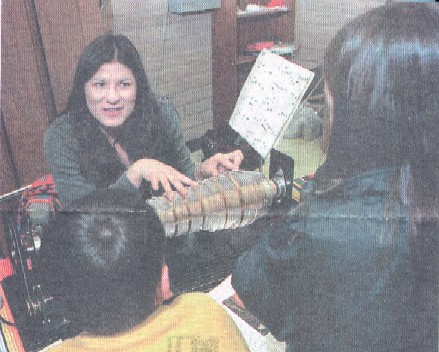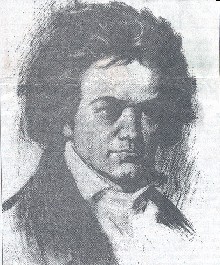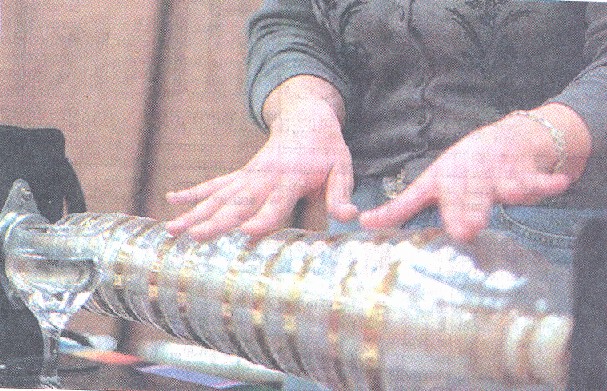
Armonica Player and Pressed Flower Artist
Click below to learn more about Mayling and her armonica




|
 Mayling performed on "America's Got Talent" nationwide on NBC during it's first
season. She was one of five unique musicians vying for a chance
to win a slot in the finals. Unfortunately, Mayling was not
selected to move forward in the contest.
Mayling performed on "America's Got Talent" nationwide on NBC during it's first
season. She was one of five unique musicians vying for a chance
to win a slot in the finals. Unfortunately, Mayling was not
selected to move forward in the contest. Below is a clip from her appearance on Thursday, July 27, 2006. This is a selection from "Over the Rainbow", music by Harold Arlen. |
|
|
![]() Click here to
return to the menu at the top
Click here to
return to the menu at the top

Sabado Gigante is a Spanish language variety show seen on television every Saturday night by 120 million viewers in 52 countries world-wide. Mayling has appeared on the show 5 times.
The pictures below, featuring Mayling with host Don Francisco, are from the 1998 Christmas Special.
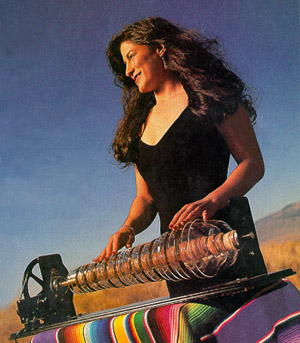

TONES OF CRYSTAL
Bowls of crystal that are used to keep food and to warm up leftovers in the microwave,
who ever imagined that people of the 18th century used them to play music? Mayling Garcia,
age 33, has dedicated her life to playing this instrument perfected by Benjamin Franklin in 1761.
Mozart and Beethoven who composed for it, popularized the instrument. The
players fell ill due to the lead content of the bowls. 
After seeing a woman play a glass armonica in Boston,
Garcia bought one
and learned to play by
telephone from the maker, whom she had never met. She is one of only twelve people in the world
to play the instrument. Garcia lives in Albuquerque, New Mexico and is creating her first compact disc.
"My life is full and my dreams are big", says Garcia.
Below is the original Spanish language version from People Magazine en Español
UNA TONADA CRISTALINA
Sabiamos que las vsijas de cristal se usan para guardar comida y calentar sobras en el microondas. ¿Quién imaginó queservían para interpretar música del siglo XVIII? Mayling Garcia, de 33 años, se gana la vida tocando el copofón, instrumento perfeccionado por Benjamin Franklin en 1761, cuando montó varios envases de cristal en un huso. Su
ejecución se popularizó (Mozart y Beethoven compusieron piezas para compofón) pero decayó cuando el plomo de las vasijas enfermó a los músicos. Garcia es una autodidacta asesorada por teléfono desde Boston por el hombre que construyó su copofón con vasijas de cuarzo, y al cual nunca ha visto. Una de 12 personas en el mundo que tocan este instrumento. Garcia de Albuquerque, Nuevo México, quistera grabar un CD y afirma que el aprendizaje la ha transformado. "Mi vida está colmada de autoestima y tengo grandes sueños", dice.
Triunfadores de costa a costa" People Magazine en Español. vol. 2 no. 2, p. 53 March 1999.
![]() Click here to
return to the menu at the top
Click here to
return to the menu at the top
Reviving glass armonica tradition (March 13, 2016)
Reviving glass armonica tradition Mayling Garcia of Corrales poses next to her glass armonica Friday. Garcia recently tried out for Americas Got Talent with the instrument, also known as a glass piano. She is one of only about a dozen people in the world who regularly play the instrument.
Corrales woman hopes to raise awareness, find fame through playing Franklin invention.
By Anne Constable
Listening to the glass armonica is "so beautiful, you could cry," Mayling Garcia says. Garcia is one of about a dozen people in the world who regularly perform on the instrument, a musical invention of Benjamin Franklin. Its haunting tones once delighted 18th-century audiences but were also believed by some to bring on insanity, nervous disorders, animal convulsions and marital disputes — and even cause the dead to awaken.
Invented by Franklin in 1761, the instrument originally was made out of lead crystal. It fell out of favor; perhaps in part because of its link to insanity.
Garcia's instrument — lead-free — has 45 tuned crystal bowls of different sizes, which are threaded on a shaft that is turned by a motor. She touches the turning edges of the quartz bowls with wet fingers to create a mes- merizing sound, much like rubbing a wet finger on a wine glass filled with water.
Her usual gigs are elementary schools, sport- ing events and senior centers in New Mexico, Jake Gold, Mayling Garcia's ancestor, owned a curio shop near the Plaza in Santa Fe. although in 2013 she performed at the New Mexico History Museum in Santa Fe during a program on Franklin, and she's been on Såbado Gigante the popular Spanish language television program, five times. She's also been featured in People en Espanol and in other magazine articles. Despite this however, the 50-year-old Corrales resident has really gained the fame she sought as one of the world's few glass armonica players.
This year, the New Mexico native auditioned for a spot on the long-running hit TV show America's Got Talent, hoping to build inter- est in the glass armonica and still longing to become famous all over the country — and the world. While she was hoping to be a contestant on the show, she also wanted to play 'The Star- Spangled Banner" on her glass armonica for the July 4 episode. So she was pitching two plans to the producers.
The audition, however; was a little rough, she admitted.
First of all, there was the sheer number of other hopefuls at the downtown convention center in Los Angeles on Feb. 6. Garcia got there at 3 p.m. and took number 933. The producers saw a new act every 90 seconds, she said. She didn't get to perform until 11:30 p.m. and the atmosphere was tense as people waited hours to be seen. One mom moaned, "I don't have the heart to tell my son he can’t be a magician anymore." A girl complained to her mother, "I can't believe you forgot my hula hoop".
When it was her turn to audition. Garcia was not able to get enough friction on her glass armonica to play the instrument well because she had washed its valves with a cloth containing Clorox. She was only able to play a little bit of "Amazing Grace."
Leaving at midnight, Garcia said, she saw a disappointed young comedian crying in the parking garage and saying, “I'll never do stand-up again."
But she didn't give up. When she got home from L.A., Garcia submitted an online audition, performing the national anthem while giving the same introduction and wearing the same dress, makeup and hairstyle that she'd presented to judges in LA. She expects to learn in the next few weeks whether she was accepted. Garcia's sister Goldie, known for her bottle cap art, also auditioned for America's Got Tålent, performing a comedy routine.
Members of Garcia's family were always hoping to make it big in the entertainment business. All five girls and boys were talented in some way, she said. Mayling, who was No. 7, was named for Mei Lin in the 1961 movie Flower Drum Song, who also wanted to work in Hollywood. Her brother Mario was in the movie Kickboxer 4: Agressor. And Goldie once had a deal in Los Angeles with Pepsi Co.
But they all have regular jobs. Along With her armonica gigs, Mayling is a waitress at a popular Corrales restaurant and makes pressed flower art. She creates collages out of pressed flowers that resemble stained glass. She was accepted into this summer’s Contemporary Hispanic Market in Santa Fe. Getting into the market was a huge step for her, she said, "because it validates you as an artist."
Her husband, Richard Trujillo, is also an artist, known for his Day of the Dead pieces and paintings with Amazonian and Mayan tribal symbols.
Garcia's family has deep roots in New Mexico. She said she is related to Jake Gold, who had a curio shop near the Santa Fe Plaza in the second half of the 19th century. The shop advertised for sale the last trousers worn by Christopher Columbus, a hat belonging to 16th-century explorer Cabeza de Vaca and a silver breastplate owned by Hernån Cortes. Gold died in the state prison, where he was incarcerated for abandoning his wife.
Wildly outgoing and obviously persistent, Garcia first came across the glass armonica, also known as the glass harmonica or glass piano, more than two dcades ago in Harvard Square. She was visiting her sister, Goldie, then a student at Harvard, and saw Vera Meyer playing for tips from tourists, It was 1987, and Garcia was 21 years old. "Every summer, I visited Goldie and would watch Vera play in the square," she said.
Garcia asked Meyer for help finding an instrument, and Meyer connected her with Gerhard Finkenbeiner, a German glassblower who was building lead-free glass armonicas in Waltham, Mass. Finkenbeiner said he believed in her dream to play the glass piano and sold her one made of crystal and gold for a deeply discounted $2500.
Then he taught her to play it over the phone.
Since then, Garcia has learned to play many classics and popular favorites on the instrument, including "Somewhere Over the Rainbow," “Let Me Call You Sweetheart," "Edelweiss," "Ave Maria" "Ode to Joy” and even Elvis Presley's "Love Me Tender."
The instrument was popular in the 18th and 19th centuries, especially in Europe, and com- posers such as Wolfgang Ama- deus Mozart and Ludwig von Beethoven wrote hundreds of pieces for it. Marie Antoinette even took lessons on the glass armonica.
"It was the biggest thing on the planet," Garcia said.
But then it became linked to mental illness and began losing its popularity. Some towns in Germany even banned it. But it also faced another problem: Music was beginning to be played in larger auditoriums, rather than the small concert halls of Mozart’s day, and the sound of the armonica was too soft to be heard in bigger venues.
Today, there seems to be a renewed interest in the armonica.
It was featured on a Linda Ronstadt album and has been used in concert performances by the Metropolitan Opera in New York City. G Finkenbeiner Inc. is still making the lead-free glass armonica. In fact, a company representative said recently that one had just been sent to California and another is being completed for the music department at the University of Notre Dame. The cost of an instrument depends on its size, but they start at nearly $8000.
Finkenbeiner is longer with the company. He disappeared one night in 1999 while flying his Piper Arrow airplane over the Massachusetts cranberry bogs. Garcia said she had been visiting with him just before he vanished. They stayed up all night talking, she said. He told her the story of how he became a glassblower in Nazi Germany and that in the process, he was able to "bring something beautiful back to the world.”
They talked again at his shop the next day, she said. Then he left, telling no one where he was going, He was never heard from again.
Two months earlier, Garcia said, Finkenbeiner had told her that all the makers of glass armonicas had experienced strange deaths.
Garcia also believes there is a strong association between the first glass armonicas and the unexpected early deaths of some musicians who played them. Mozart, for example, died at 35. Garcia believes Mozart suffered from lead poisoning, though the cause of his death is still widely debated.
“This instrument is a trip," Garcia said. "I am Franklin's American dream. He desired a country where I, Mayling, of Mexican, Polish and Italian descent, could grow up and take a shot at being one of the world's (few) glass armonica performers. A shot at your dreams, wherever they may be."
![]() Click here to
return to the menu at the top
Click here to
return to the menu at the top



An Instrument of the Past (November 2016)
Mayling Garcia is one of just a handful of people on the planet who can play the glass armonica, invented by Benjamin Franklin in the 1700s.
Imagine being on one of the most watched talent shows in the United States in front of a live audience, where you won't be singing or dancing—you'll be performing on a notoriously delicate instrument that few people have even heard of. Palms sweaty, heart thumping, the producers of "America's Got Talent" say you have just 45 seconds. You probably wouldn't think to steal the spotlight from Regis Philbin, but that's exactly what Mayling Garcia did.
"I cannot even tell you how horrified I was," she says. "But ten seconds before I went on, I told myself to be strong, and a calm came over me. I didn't let Regis talk -- I introduced myself and started playing my glass armonica."
The glass armonica is an instrument that almost disappeared after gaining popularity with the likes of Wolfgang Amadeus Mozart, Ludwig van Beethoven, and Marie Antoinette in the late 1700s. According to Garcia, Benjamin Franklin was inspired to invent the instrument after witnessing a crystal flute player who played water filled wine glasses by wetting his fingers and circling the tops of each glass. "He thought the instrument displayed perfect pitch without having to tune and tone like a piano," Garcia says. "The first time he played it, his wife thought she died and went to heaven."
The original instrument consisted of sequentially sized lead crystal bells stacked on each other with an anchoring rod running through the center. A motor spins the rod, so they're in constant rotation. The 22•karat gold edges signify the black keys of a piano. The player wets her fingers and gently places them on the bells to create sounds in different pitches.
Garcia is one of only a handful Of people in the world to play and educate people about the mysterious history Of the instrument. She began checking out books from the library to compile research on Benjamin Franklin and the Instrument's scant history. She discovered the instrument was banned due to accusations of witchcraft and a strange history Of players "going mad." She maintains a theory that these four people who did died of plumbism, or lead poisoning, due to the glass armonica.
To be an ambassador of something that's been lost to the sands of time may seem like a strange endeavor, but once Garcia saw the instrument played for the first time, she had to get her hands on one.
When she was 21, she visited her sister while she was attending Harvard University and happened upon the instrument in Hartford Square. "There was this crowd from all walks of life, young and old, and the performer had a lot of money in her tip jar," she says. "When I saw what she was playing, my mouth dropped." She stayed for the next three years as an assistant to the player, Vera, but returned home in 1989. She went on with her life, not knowing where her focus was until she got a sign.
"At 28, I asked God to please help me seek out my potential. I happened to look at a box on my dresser, and there was Vera’s card," she says. From that point on, it became her mission to acquire an armonica, learn to play it, and share it with the world.
That was no easy task. After speaking with Vera, she was given Gerhard Finkenbeiners’ number, the founder of the glass company, G. Finkenbeiner, Inc. Although the company specializes in scientific glassware, he made glass armonicas as a hobby.
"I told him I wanted to show the world this amazing instrument, and he told me, ‘What you are attempting is impossible; there's no one to teach you, so you'd have to learn over the phone" Garcia says. With no musical experience, she convinced him of her tenacity to make this happen. "I guess I spoke a good line because he sold me an instrument for half-price right over the phone," she says.
Garcia and Finkenbeiner stayed in contact and he taught her to play long-distance and how to repair the motor for her to be as self-sufficient as possible
. “He began to believe in me and would give me more and more information about the history and what songs to learn," says Garcia. "There was so much to learn, music theory, how to play, learning to speak in public, but I began playing for children for free, and that helped me.
" Transporting the instrument is difficult, and it usually results in one of the pieces breaking. Luckily, the company still takes repairs of the delicate, unleaded crystal and quartz bells and will melt them down and re-shape them.
Due to its fragile nature, Garcia doesn't see the armonica surviving the next century. "All the players are getting old and not playing, Mr. Finkenbeiner is gone. I don't know who would make them and I don't know who would have as much stamina as I did to keep going with all the problems."
But Garcia hasn't let that stop her. She travels with her golden instrument nationwide, even internationally. "I was on 'Sabado Gigante,' which reaches 120 million people in 52 countries," she says. "My parents used to watch it all the time, so for me to actually be on there was amazing.
" Looking back, Garcia wouldn't trade her experiences. "I preach about motivation because I started with no experience and landed on the biggest show in the world," she says. "People say, 'Yeah, but you're broke,' but it doesn't matter. I still had limos, hair, makeup, TV shows. The experience far exceeded any amount of money I would have made."
According to Garcia, none of this would have been possible without a com-munity that believed in her, a community that now supports her as a waitress and a pressed-flower artist, With her work on display at the Contemporary Spanish Market. "My state has helped me to give the glass armonica the most exposure it's had since Ben Franklin's time," says Garcia. "I'm so thankful to my state, my people—mi gente—who've helped me.-
—OLIVIA TORRESO
![]() Click here to
return to the menu at the top
Click here to
return to the menu at the top
This article ran in many newspapers nationwide during the last weeks of February 2001. (AP Photos by Roberto E. Rosales.)
The glass armonica, invented by Benjamin Franklin in 1761, was demonstrated to Ludwig van Beethoven and Wolfgang Amadeus Mozart when Franklin visited France during the American Revolution. Both composers then wrote music for the instrument, which created an international sensation--and superstition.
The instrument consists of blown crystal bowls, in graduated sizes, arrayed along a spindle that rotates while the player
places moistened fingers on them. In the early history of the instrument, lead glass stemware was
sometimes used instead
of crystal, and leaded paint was applied to some of the bowls to differentiate those notes.
A 582-strand Beethoven hair sample, taken just after his death at age 56 in 1827, was purchased at auction for $7,300 in
1994 by Ira Brilliant, founder of the Center for Beethoven Studies at San Jose State University, and Alfredo Guevara, a
surgeon from Nogales, Ariz. |
Benke, Richard. "Armonica use may have led to Beethoven's death." AP Wire 25 Feb. 2001, natl. ed
![]() Click here to
return to the menu at the top
Click here to
return to the menu at the top
![]()
In December 1998, the editors of Hispanic Business Magazine selected a number of Hispanic-owned businesses that "possess a remarkable business concept, marketing niche, organizational approach, or success story" as winners of the 1998 Entrepreneurial Spirit Awards. Mayling was selected as one of these winners.
Making Music from Gold and Glass

Photo by Mike Grady |
Mayling Garcia bills herself as the only Latina who plays the glass
armonica - a reasonable claim given that only 100 such instruments exist
in the world. Invented by Benjamin Franklin in 1761, the glass armonica
works on the idea that when a wet finger rubs the rim of a wineglass, it
produces a pure note. Unfortunately, Mr. Franklin built his models with
lead crystal, and the players developed lead poisoning.
In 1940, a German scientist resurrected the idea, incorporating gold instead of lead. Ms Garcia purchased a lead-free instrument in 1993, learned to play via telephone with the German scientist, and launched her musical career under her Albuquerque-based company Mayling Garcia Glass Armonica Performer. |
| In addition to performing at schools and private functions, she has played three gigs on the Univision variety show "Sabado Gigante." Producers have contacted her about playing "The Star Spangled Banner" at next month's Superbowl. |
![]() Click here to
return to the menu at the top
Click here to
return to the menu at the top

A monthly feature of New Mexico Magazine is called "Asi
Es Nuevo Mexico" "This is New Mexico" which spotlights
exceptional New Mexican people and organizations. Mayling was featured in
the February 1997 edition.

Albuquerque musician keeps in touch with history
- Jim Bowman
An Albuquerque musician is doing her part to erase a blotch on the otherwise sterling record of American statesman and inventor extraordinaire, Ben Franklin.
Mayling Garcia, at 31, has become a living link to Franklin, the youngest person in the world and only Hispanic to master his illfated instrument, the glass armonica.
Franklin introduced the glass armonica - a strange cross between a harpsichord and a xylophone - in 1761. Concertgoers heralded ani invention they thought might rival the lighning rod , bifocals, and the Franklin stove in importance. Even the era's musical titans, Beethoven and Mozart, wrote compositions specifically for the instrument.
But by 1830, the last of
Franklin's glass armonicas had been banished to dank storage rooms in
museums and the vaults of wealthy families. The public hadn't grown tired
of the sweet, high-pitched melodies produced by the armonica. But no one
wanted to touch the instruments because those who did so often went
stark-raving mad.
Some critics accused Franklin of fomenting witchcraft. Others conjectured that the glass armonica's piercing sounds caused players to lose their sanity.
Only in recent years has the mystery been solved. Franklin used leaded crystal in manufacturing the 45 glass bowls that form the core of the instrument. Since it's played by physically rubbing the rims of the bowls, musicians of the era fell victim to lead poisoning, absorbed directly through their fingertips and into their bloodstreams.
Garcia faces no such risk. She's playing a new, lead-free model of the glass armonica, developed by a German glass blower in the 1980s. When she first heard the strange instrument played during a concert in Harvard Square, Garcia knew she had to try her own hand at it. But because she had little formal musical training, she was reluctant to invest the several thousand dollars required to purchase a glass armonica.
After years of procrastinating, Garcia took the plunge, buying an instrument and resolved to teach herself to play "by trial and error, if need be". Eventually, she succeeded, though she admits tying up her family's phone line dialing an 800 toll-free number set up by the manufacturer to seek assistance.
Garcia now gives frequent public concerts, once playing the National Anthem on the glass armonica to open an Albuquerque Dukes baseball game. Her repertoire includes classical favorites, as well as children's songs, Christmas carols and traditional Hispanic folk tunes.
"My dad used to ask, 'Why don't you get a real job?,'" she says. "Now he's proud of what I have accomplished."
"Albuquerque musician in touch with history" Jim Bowman, New Mexico Magazine. vol. 75 no. 2, p. 16 February 1997. Photos by Mike Grady
![]() Click here to
return to the menu at the top
Click here to
return to the menu at the top
![]()
In the June 1997 edition of The Santa Fean Magazine,
Mayling was featured in their regular section entitled "Tales of the
'City Different' ".

Music of the Hemispheres
-- Perrin Patterson
Witchcraft, lead-poisoning and mystery ... the armonica has a story to tell and Albuquerque-based performer Mayling Garcia intends to narrate. Inspired by water-filled musical glasses, Benjamin Franklin constructed the odd-looking instrument in 1761. Comprised of concentric glass bowls lined horizontally along a revolving rod and played with moistened finger tips, the otherworldly sounding, high-pitched instrument enjoyed global popularity - Mozart even composed a quintet for it.
The popularity ended, however, when people began to notice certain deranging effects it seemed to have on it's players. Rumors of witchcraft spread. Franklin's invention was considered his greatest failure and, "by 8130, playing the instrument in public had been banned. If you played the armonica at all, you were considered evil," says Garcia. However, she has a more logical explanation for the strange behavior attributed to glass armonica musicians; lead-poisoning. The glass bowls of the armonica were made of lead crystal, and the toxin, Garcia says, seeped through finger pores and poisoned the players.
Now, using bowls hand-blown from lead-free crystal, Garcia wants to help us rediscover this unusual instrument.. One of only six musicians in the world who play the armonica publicly, Garcia has her work cut out for her. You can often her find her carefully lugging the thirty-pound instrument to private parties and children's events across New Mexico. Call Mayling Garcia for a chance to hear this misunderstood melody-maker; she has armonica, will travel.
"Music of the Hemispheres" Perrin Patterson, The Santa Fean Magazine. vol. 25 no. 5, p. 11 June 1997.
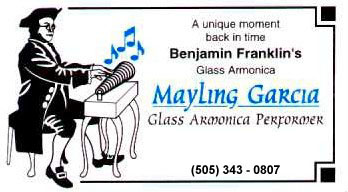
Mayling Garcia can be contacted at the number and address above
or
by e-mail at



